Chapter 2
Getting to Know Your Honey Bees
IN THIS CHAPTER
 Recognizing bee parts and what they do
Recognizing bee parts and what they do
 Exploring how bees communicate with each other
Exploring how bees communicate with each other
 Getting acquainted with the two female castes and the male
Getting acquainted with the two female castes and the male
 Understanding the honey bee life cycle
Understanding the honey bee life cycle
 Distinguishing the differences between honey bees and similar insects
Distinguishing the differences between honey bees and similar insects
My first introduction to life inside the honey bee hive occurred many years ago during a school assembly. I was about 10 years old. My classmates and I were shown a wonderful movie about the secret inner workings of the beehive. The film mesmerized me. I’d never seen anything so remarkable and fascinating. How could a bug be so smart and industrious? I couldn’t help being captivated by the bountiful honey bee. That brief childhood event planted a seed that blossomed into a treasured hobby decades later.
Anyone who knows even a little bit about the honey bee can’t help but be amazed, because far more goes on within the hive than most people can ever imagine: complex communication, social interactions, teamwork, unique jobs and responsibilities, food gathering, and the engineering of one of the most impressive living quarters found in nature. Whether you’re a newcomer or an old hand, you’ll have many opportunities to experience firsthand the miracle of beekeeping. Every time you visit your bees, you’ll see something new. But you’ll get far more out of your new hobby if you understand more about what you’re looking at. What are the physical components of the bee that enable it to do its job so effectively? What are those bees up to and why? What’s normal and what’s not normal? What is a honey bee, and what is an imposter? In this chapter, you take a peek within a typical colony of honey bees.
Basic Body Parts
Everyone knows about at least one part of the honey bee’s anatomy: its stinger. But you’ll get more out of beekeeping if you understand a little bit about the other parts that make up the honey bee. I don’t go into this in textbook-detail — I just show you a few basic parts to help you understand what makes honey bees tick. Figure 2-1 shows the basic parts of the worker bee.
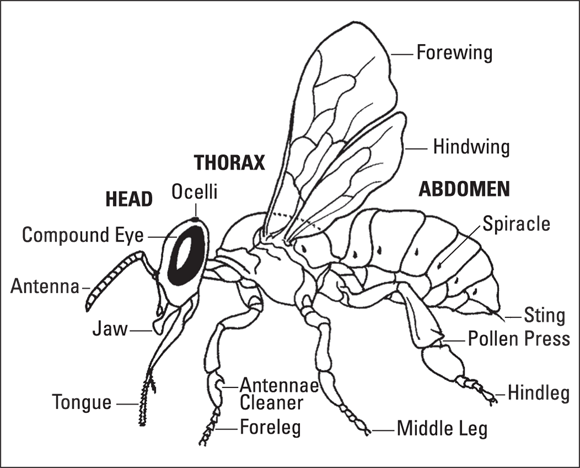
Courtesy of Howland Blackiston
FIGURE 2-1: This is how a honey bee looks if you shave off all the hairs. Several important body features are labeled.
Skeleton
Like all insects, the honey bee’s skeleton is on the outside. This arrangement is called an exoskeleton. On the outside, nearly the entire bee is covered with branched hairs (like the needles on the branch of a spruce tree). Yes, the hairs help keep the bee body warm, but they also do much more. A bee can “feel” with these hairs, and the hairs serve the bee well when it comes to pollination because pollen sticks well to the branched hairs.
Head
The honey bee’s head is flat and somewhat triangular in shape. Here’s where you find the bee’s brain and primary sensory organs (sight, feel, taste, and smell). It’s also where you find important glands that produce royal jelly and some of the various chemical pheromones used for communication. Figure 2-2 compares the heads of a worker, drone, and queen.
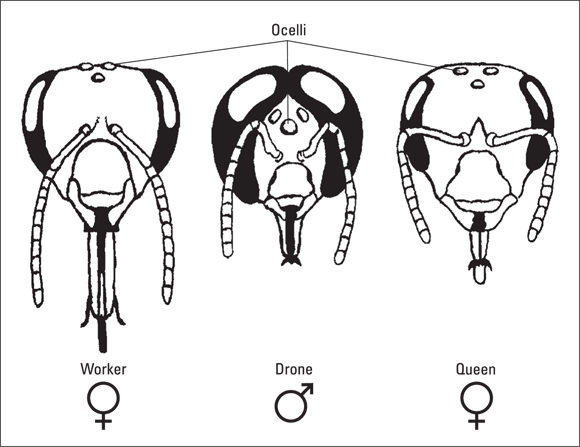
Courtesy of Howland Blackiston
FIGURE 2-2: Comparing the heads of worker, drone, and queen bees. Note the worker bee’s extra-long proboscis and the drone’s huge, wraparound eyes.
Royal jelly is a substance secreted from glands in a worker bee’s head and is used as a food to feed brood.
The important parts of the bee’s head are its
- Eyes: The head includes two large, compound eyes that are used for general-distance sight, and three small, simple eyes, called ocelli, which are used in the poor light conditions within the hive. Notice the three simple eyes (ocelli) on all three bee types Figure 2-2, while the huge, wraparound, compound eyes of the drone make him easy to identify. The queen’s eyes, are slightly smaller than the worker bee’s and much smaller than the drone’s.
- Antennae: The honey bee has two elbowed antennae on the front of its face. Each antenna has thousands of tiny sensors that detect smell (like a nose does). The bee uses this sense of smell to identify flowers, water, the colony, and maybe even you! The antennae also, like the branched hairs mentioned earlier, feel, detect moisture, measure distance when bees fly, and help the bee detect up and down, among other functions.
- Mouth parts: The bees’ mandibles (jaws) are used for feeding larvae, collecting pollen, manipulating wax, and carrying things.
- Proboscis: Everyone’s familiar with those noisemakers that show up at birthday and New Year’s Eve parties. You know, the ones that unroll when you toot them! The bee’s proboscis is much like those party favors, only without the “toot.” When the bee is at rest, this organ is retracted and not visible. But when the bee is feeding or drinking, it unfolds and two basic parts to form a long tube that the bee uses like a straw.
Thorax
The middle part of the bee is the thorax. It is the segment between the head and the abdomen where the two pairs of wings and six legs are anchored.
- Wings: Here’s a trivia question for your next party: How many wings does a honey bee have? The answer is four. Two pairs are attached fore and aft to the bee’s thorax. The wings are hooked together in flight and separate when the bee is at rest.
- Legs: The bee’s three pairs of legs are all different. Each leg has multiple segments that make the legs quite flexible. Bees also have taste receptors on the tips of their legs. The bee uses its forward-most legs to clean its antennae. The middle legs help with walking and are used to pack loads of pollen (and sometimes propolis) onto the pollen baskets that are part of the hind legs. Propolis is the sticky, resinous substance that the bees collect from the buds of trees and use to seal up cracks in the hive. Propolis can be harvested and used for a variety of nifty products. (For more information on propolis and what you can do with it, see Chapter 18.) The hind legs (see Figure 2-3) are specialized on the worker bee. They contain special combs and a pollen press, which are used by the worker bee to brush, collect, pack, and carry pollen and propolis back to the hive. Take a moment to closely watch a foraging bee on a flower. You’ll see her hind legs heavily loaded with pollen for the return trip home.
- Spiracles: These tiny holes along the sides of a bee’s thorax and abdomen are the means by which a bee breathes. The bee’s trachea (breathing tubes) are attached to these spiracles. Tracheal mites gain access to the trachea through the first hole in the thorax. These mites are a problem for bees; you find out how to deal with tracheal mites in Chapter 13.
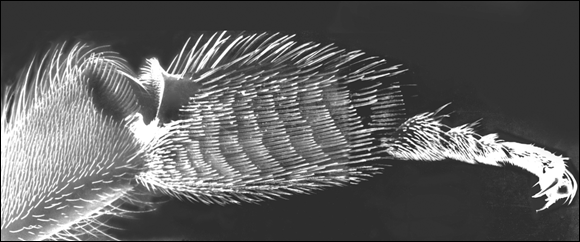
Courtesy of Dr. Eric Erickson, Jr.
FIGURE 2-3: In this close-up image of a worker bee’s leg, you can clearly see the hairs that serve as brushes to collect pollen.
Abdomen
The abdomen is the part of the bee’s body that contains its digestive organs, heart, reproductive organs, wax and scent glands (workers only), and, of course, the infamous stinger (workers and queen only).
The Amazing Language of Bees
It is said that only man and primates have a form of communication superior to that of the honey bee. Like you and I, honey bees use five senses throughout their daily lives; however, honey bees have additional communication aids at their disposal. Two of the methods by which they communicate are of particular interest. One is chemical, the other choreographic.
Pheromones
Pheromones are chemical scents that animals produce to trigger behavioral responses from the other members of the same species. Honey bee pheromones provide the “glue” that holds the colony together. The three types of adults in a hive, of which more is mentioned later in this chapter, produce different pheromones at different times to stimulate specific behaviors. The study of pheromones is a topic worthy of an entire book, so here are just a few basic facts about the ways pheromones help bees communicate:
- Certain queen pheromones (known as queen substance, discussed at greater length later in this chapter) let the entire colony know that the queen is in residence and stimulate many worker-bee activities.
- Outside of the hive, the queen pheromones act as a sex attractant to potential suitors (male drone bees from other colonies). They also help regulate the drone (male bee) population in the hive.
- Queen pheromones stimulate many worker-bee activities, such as comb-building, brood-rearing, foraging, and food storage.
- The worker bees at the hive’s entrance produce pheromones that help guide foraging bees back to their hive. The Nasonov gland (discussed later in this chapter) at the tip of the worker bee’s abdomen is responsible for this alluring scent.
- Worker bees produce alarm pheromones that can trigger sudden and decisive aggression from the colony.
- The colony’s brood (developing bee larvae and pupae) secretes special pheromones that help worker bees recognize the brood’s gender, stage of development, and feeding needs.
Shall we dance?
Perhaps the most famous and fascinating “language” of the honey bee is communicated through a series of dances done by foraging worker bees who return to the hive with news of nectar, pollen, or water. The worker bees dance on the comb using precise patterns. Depending on the style of dance, a variety of information is shared with the honey bees’ sisters. They’re able to obtain remarkably accurate information about the location and type of food the foraging bees have discovered.
Two common types of dances are the round dance and the waggle dance.
The round dance communicates that the food source is near the hive (within 10–80 yards). Figure 2-4 illustrates dancing movements.
For a food source found at a greater distance from the hive, the worker bee performs the waggle dance. It involves a shivering side-to-side motion of the abdomen while the dancing bee moves in a figure eight pattern. The vigor of the waggle, the number of times it is repeated, the direction of the dance, and the sound the bee makes communicate amazingly precise information about the location of the food source. See Figure 2-4.
The dancing bees pause between performances to offer potential recruits a taste of the goodies they bring back to the hive. Combined with the dancing, the samples provide additional information about where the food can be found and what type of flower it is from.

Courtesy of Howland Blackiston
FIGURE 2-4: The round dance (top) and the waggle dance (bottom).
Getting to Know the Male and the Two Female Castes
During summer months, about 60,000 or more bees reside in a healthy hive. And while you may think that all those insects look exactly alike, the population actually includes two different female castes (the queen and the workers) and the male bees (drones; see Figure 2-5). Each type has its own characteristics, roles, and responsibilities. Upon closer examination, the three look a little different. Being able to distinguish one from the other is important.
Her majesty, the queen
Let there be no mistake about it — the queen bee is the heart and soul of the colony. There is only one queen bee in a colony. She is the reason for nearly everything the rest of the colony does. The queen is the only bee without which the rest of the colony cannot survive. Without her, your hive is sunk. A good-quality queen means a strong and productive hive. For more information on how to evaluate a good queen, see Chapter 8. And for some real fun, try raising your own queens from your best performing hives. See Chapter 14.
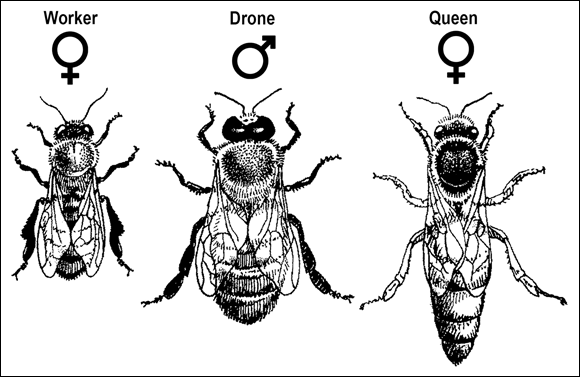
Courtesy of Howland Blackiston
FIGURE 2-5: These are the three types of bees in the hive: worker, drone, and queen.
The queen is the largest bee in the colony, with a long and graceful body. She is the only female with fully developed ovaries. The queen’s two primary purposes are to produce chemical scents that help regulate the unity of the colony and to lay eggs — and lots of them. She is, in fact, an egg-laying machine, capable of producing more than 1,500 eggs a day at 30-second intervals. That many eggs are more than her body weight!
The other bees pay close attention to the queen, tending to her every need. Like a regal celebrity, she’s always surrounded by a flock of attendants as she moves about the hive (see Figure 2-6). Yet, she isn’t spoiled. These attendants are vital because the queen is incapable of tending to her own basic needs. She can neither feed nor groom herself. She can’t even leave the hive to relieve herself. And so her doting attendants (the queen’s court, her retinue) take care of her basic needs while she tirelessly goes from cell to cell doing what she does best: lay eggs.
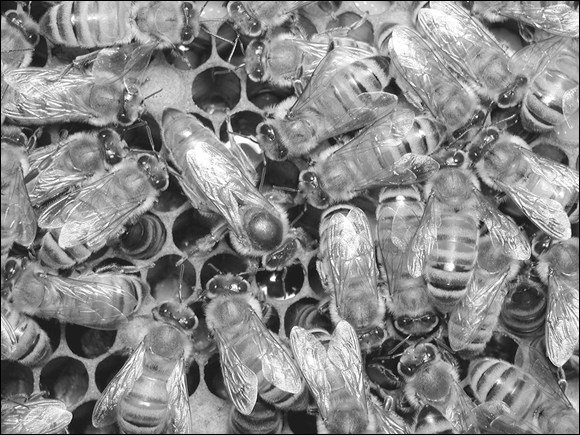
Courtesy of USDA-ARS
FIGURE 2-6: A queen and her attentive attendants.
The gentle queen bee has a stinger, but it is rare for a beekeeper to be stung by a queen bee. I have handled many queen bees and have never been stung by any of them. In general, queen bees use their stingers only to kill rival queens that may emerge or be introduced in the hive.
The queen can live for two or more years, but replacing your queen after a season or two ensures maximum productivity and colony health. Many seasoned beekeepers routinely replace their queens every year after the nectar flow. This practice ensures that the colony has a new, energetic, and fertile young queen each season. You may wonder why you should replace the queen if she’s still alive. That’s an easy one: As a queen ages, her egg-laying capability slows down, which results in less and less brood each season. Less brood means a smaller colony. And a smaller colony means a lackluster honey harvest for you! For information on how to successfully introduce a new queen, see Chapter 10. For information on how to raise your own queens (now, that’s fun!), see Chapter 14.
The industrious little worker bee
The majority of the hive’s population consists of worker bees. Like the queen, worker bees are all female. Worker bees that are younger than 3 weeks old have working ovaries and can lay eggs, but they are not fertile, as the workers never mate and therefor lack sperm to fertilize eggs. Workers also look different than the queen. They are smaller, their abdomens are shorter, and on their hind legs they possess pollen baskets, which are used to tote pollen back from the field.
Like the queen, the worker bee has a stinger. But her stinger is not a smooth syringe like the queen’s. The sting is three-shafted, with each shaft having barbs (resemble a fish hook). The barbs cause the stinger, venom sack, and a large part of the bee’s gut to remain in a human victim — a Kamikaze effort to protect the colony. Only in mammals (such as humans) does the bee’s stinger get stuck. The worker bee can sting other insects again and again while defending its home.
The life span of a worker bee is a modest six weeks during the colony’s active season. However, worker bees live longer (four to eight months) during the less-active winter months. These winter workers are loaded with protein and are sometimes referred to as “Fat Bees.” The term “busy as a bee” is well earned. Worker bees do a considerable amount of work, day in and day out. They work as a team. Life in the hive is one of compulsory cooperation. What one worker could never do on her own can be accomplished as a colony. During the busy season, the worker bees literally work themselves to death. The specific jobs and duties they perform during their short lives vary as they age. Understanding their roles will deepen your fascination and appreciation of these remarkable creatures.
From the moment a worker bee emerges from her cell, she has many and varied tasks clearly cut out for her. As she ages, she performs more and more complex and demanding tasks. Although these various duties usually follow a set pattern and timeline, they sometimes overlap. A worker bee may change occupations, sometimes within minutes, if there is an urgent need within the colony for a particular task. They represent teamwork and empowerment at their best!
Initially, a worker’s responsibilities include various tasks within the hive. At this stage of development, worker bees are referred to as house bees. As they get older, their duties involve work outside of the hive as field bees.
House bees
Worker honey bees spend the first few weeks of their lives carrying out very specific tasks within the hive. For this reason, they are referred to as house bees. The jobs they do (described in the following sections) are dependent on their age.
Housekeeping (days 1 to 3)
A worker bee is born with the munchies. Immediately after she emerges from the cell and grooms herself, she engorges herself with pollen and honey. Following this binge, one of her first tasks is cleaning out the cell from which she just emerged. This cell and other empty cells are cleaned and polished and left immaculate to receive new eggs or to store nectar and pollen.
Undertaking (days 3 to 16)
The honey bee hive is one of the cleanest and most sterile environments found in nature. Preventing disease is an important early task for the worker bee. During the first couple weeks of her life, the worker bee removes any bees that have died and disposes of the corpses as far from the hive as possible. Similarly, diseased or dead brood are quickly removed before becoming a health threat to the colony.
Should a larger invader (such as a mouse) be stung to death within the hive, the workers utilize propolis to deal with that situation. Obviously a dead mouse is too big for the bees to carry off. So the workers completely encase the corpse with propolis (a brown, sticky resin collected from trees and sometimes referred to as bee glue). Propolis has significant antibacterial qualities. In the hot, dry air of the hive, the hermetically sealed corpse becomes mummified and is no longer a source of infection. The bees also use propolis to seal cracks and varnish the inside walls of the hive.
Working in the nursery (days 4 to 12)
The young worker bees tend to their baby sisters by feeding and caring for the developing larvae. On average, nurse bees check a single larva 1,300 times a day. They feed the larvae a mixture of pollen and honey, and royal jelly — rich in protein and vitamins — produced from the hypopharyngeal gland in the worker bee’s head. The number of days spent tending brood depends on the amount of brood in the hive and the urgency of other competing tasks.
Attending royalty (days 7 to 12)
Because her royal highness is unable to tend to her most basic needs by herself, some of the workers do these tasks for her. They groom and feed the queen and even remove her excrement from the hive. These royal attendants also coax the queen to continue to lay eggs as she moves about the hive.
Stocking the pantry (days 12 to 18)
During this stage of their life, young worker bees take nectar from foraging field bees that are returning to the hive. These house bees deposit this nectar into cells earmarked for this purpose. They add an enzyme to the nectar and set about fanning the cells to evaporate the water content and turn the nectar into ripened honey. The workers similarly take pollen from returning field bees and pack the pollen into other cells. Both the ripened honey and the pollen, which is often referred to as bee bread, are food for the colony.
Fanning (days 12 to 18)
Worker bees also take a turn at controlling the temperature and humidity of the hive. During warm weather and during the honey flow season, you’ll see groups of bees lined up at one side of the entrance, facing the hive. They fan furiously to draw air into the hive. Additional fanners are in position within the hives. This relay of fresh air helps maintain a constant temperature (93 to 95 degrees Fahrenheit [34 to 35 degrees Celsius]) for developing brood. The fanning also hastens the evaporation of excess moisture from the curing honey. Chapter 15 takes a detailed look at what makes honey so special.
The workers also perform another kind of fanning, but it isn’t related to climate control. It has more to do with communication. The bees have a scent gland located at the end of their abdomen called the Nasonov gland. You’ll see worker bees at the entrance with their abdomens arched and the moist pink membrane of this gland exposed (see Figure 2-7). They fan their wings to release this pleasant, sweet odor into the air. You can actually smell it sometimes as you approach the hive. The pheromone is highly attractive and stimulating to other bees and serves as an orientation message to returning foragers, saying: “Come hither, this is your hive and where you belong.”
Beekeepers can purchase synthetic queen-bee pheromone and use this chemical to lure swarms of bees into a trap. The captured swarm then can be used to populate a new hive.
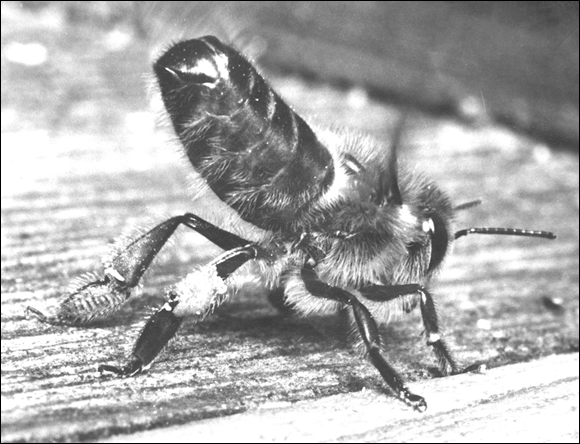
Courtesy of Bee Culture Magazine
FIGURE 2-7: This worker bee fans her wings while exposing her Nasonov gland to release a sweet orientation scent. This helps direct other members of the colony back to the hive.
Becoming architects and master builders (days 12 to 35)
Worker bees that are about 12 days old are mature enough to begin producing beeswax. These white flakes of wax are secreted from wax glands on the underside of the worker bee’s abdomen. They help with the building of new wax comb and in the capping of ripened honey and brood cells containing developing pupae.
Some new beekeepers are alarmed when they first see these wax flakes on the bee. They wrongly think these white chips are an indication of a disease or mite problem. While working, numbers of the wax flakes will fall to the bottom. Nothing to be alarmed about.
Guarding the home (days 18 to 21)
The last task of a house bee before she ventures out is that of guarding the hive. At this stage of maturity, her sting glands have developed to contain an authoritative amount of venom. You can easily spot the guard bees at the hive’s entrance. They are poised and alert, checking each bee that returns to the hive for a familiar scent. Only family members are allowed to pass. Strange bees, wasps, hornets, and other creatures intent on robbing the hive’s vast stores of honey are bravely driven off.
Bees from other hives are occasionally allowed in when they bribe the guards with nectar. These bees simply steal a little honey or pollen and then leave.
Field bees
When the worker bee is a few weeks old, she ventures outside the hive to perform her last and perhaps most important job — to collect the pollen and nectar that will sustain the colony. With her life half over, she joins the ranks of field bees until she reaches the end of her life.
It’s not unusual to see field bees taking their first orientation flights. The bees face the hive and dart up, down, and all around the entrance. They’re imprinting the look and location of their home before beginning to circle the hive and progressively widening those circles, learning landmarks that ultimately will guide them back home. At this point, worker bees are foraging for pollen (see Figure 2-8), nectar, water, and propolis (resin collected from trees).
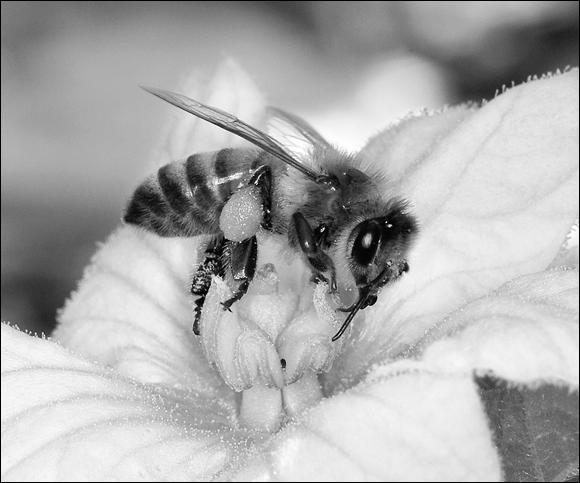
Courtesy of USDA-ARS, Stephen Ausmus
FIGURE 2-8: This bee’s pollen baskets are filled. She can visit ten flowers every minute and may visit more than 600 flowers before returning to the hive.
Foraging bees visit 5 million flowers to produce a single pint of honey. They forage a 2- to 3-mile radius from the hive in search of food (even more if necessary for water), and propolis. That’s the equivalent of several thousand acres! So don’t think for a moment that you need to provide everything they need on your property. They’re ready and willing to travel.
Foraging is the toughest time for the worker bee. It’s difficult and dangerous work, and it takes its toll. They can get chilled as dusk approaches and die before they can return to the hive. Sometimes they become a tasty meal for a bird or other insect. You can spot the old girls returning to the hive. They’ve grown darker in color, and their wings are torn and tattered. This is how the worker bee’s life draws to a close working diligently right until the end.
The woeful drone
This brings us to the drone, the male bee in the colony. Drones make up a relatively small percentage of the hive’s total population. At the peak of the season, their numbers may be only in the hundreds. You rarely find more than a thousand.
New beekeepers often mistake a drone for the queen, because he is larger and stouter than a worker bee. But his shape is in fact more like a barrel (the queen’s shape is thinner, more delicate, and tapered). The drone’s eyes are huge and seem to cover his entire head. He doesn’t forage for food from flowers — he has no pollen baskets. He doesn’t help with the building of comb — he has no wax-producing glands. Nor can he help defend the hive — he has no stinger. He is not the queen or a worker — merely the drone.
The drone gets a bad rap in many bee books. Described as lazy, glutinous, and incapable of caring for himself, you might even begin wondering what he’s good for.
He mates! Procreation is the drone’s primary purpose in life. Despite their high maintenance (they must be fed and cared for by the worker bees), drones are tolerated and allowed to remain in the hive because they are needed to mate with a new virgin queen from another colony (when the old queen from that other colony dies or needs to be superseded). Mating occurs outside of the hive in mid-flight, 200 to 300 feet in the air. This location is known as the “Drone Congregation Area,” and it can be a mile or more away from the hive. The drone’s big eyes come in handy for spotting virgin queens who are taking their nuptial flights.
The few drones that do get a chance to mate are in for a sobering surprise. They die after mating! That’s because their sex organ fits something like a key into a lock so they can effectively discharge their sperm into the queen.The queen will mate with several drones during her nuptial flight. After mating with the queen, the drone’s most personal apparatus and a significant part of its internal anatomy is torn away, and it falls to its death, a fact that prompts empathetic groans from the men in my lectures and some unsympathetic cheers from a few women.
Once the weather gets cooler and the mating season comes to a close, the workers do not tolerate having drones around. After all, those fellows have big appetites and would consume a tremendous amount of food during the perilous winter months. So in cooler climates at the end of the nectar-producing season, the worker bees systematically expel the drones from the hive. Drones are literally tossed out the door. For those beekeepers who live in areas that experience cold winters, this is your signal that the beekeeping season is over for the year.
Depending on where you live, the calendar of events for you and your bees varies depending on temperature ranges and the time of year. To read more about the beekeeper’s calendar in your part of the world, see the information and chart in Chapter 9.
The Honey Bee Life Cycle
In regions where winter means “cold,” the hive is virtually dormant. The adult bees are in a tight cluster for warmth, and their queen is snugly safe in the center of it all. But as the days lengthen and the spring season approaches, the bees begin feeding the queen royal jelly. This special food (secreted from the glands near the workers’ mandibles) is rich in protein and stimulates the queen to start laying eggs.
Like butterflies, honey bees develop in four distinct phases: egg, larva, pupa, and adult. The total development time varies a bit among the three types of bees, but the basic miraculous process is the same: 16 days for queens, 21 days for worker bees, and 24 days for drones.
Egg
The metamorphosis begins when the queen lays an egg. You should learn how to spot eggs because that is one of the most basic and important skills you need to develop as a beekeeper. It isn’t an easy task because the eggs are mighty tiny (only about 1.7 millimeters long). But finding eggs is one of the surest ways to confirm that your queen is alive and well. It’s a skill you’ll use just about every time you visit your hive.
The queen lays a single egg in each cell that has been cleaned and prepared by the workers to raise new brood (see Figure 2-9). The cell must be spotless, or she moves on to another one.
If she chooses a standard worker-size cell, she releases a fertilized egg into the cell. That egg develops into a worker bee (female). But if she chooses a wider, drone-size cell, the queen releases her egg but not sperm; for example, a nonfertilized egg. That egg develops into a drone bee (male). The workers that build the cells regulate the ratio of female worker bees to male drone bees. They do this by building smaller cells for female worker bees and larger cells for male drone bees.
Having said all that, not all fertilized eggs develop into worker bees. Some can develop into a regal queen bee. But more on that in Chapter 14.
The queen positions the egg in an upright position (standing on end) at the bottom of a cell. That’s why they’re so hard to see. When you look straight down into the cell, you’re looking at the minuscule diameter of the egg, which is only 0.4 millimeter wide. Figure 2-10 shows a microscopic close-up of a single egg.
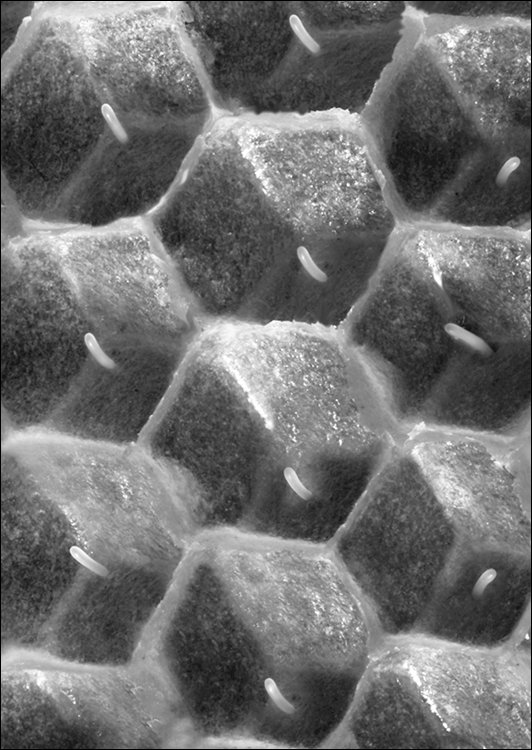
Courtesy of Howland Blackiston
FIGURE 2-9: Note the rice-like shape of the eggs and how the queen has positioned them standing up in the cells.
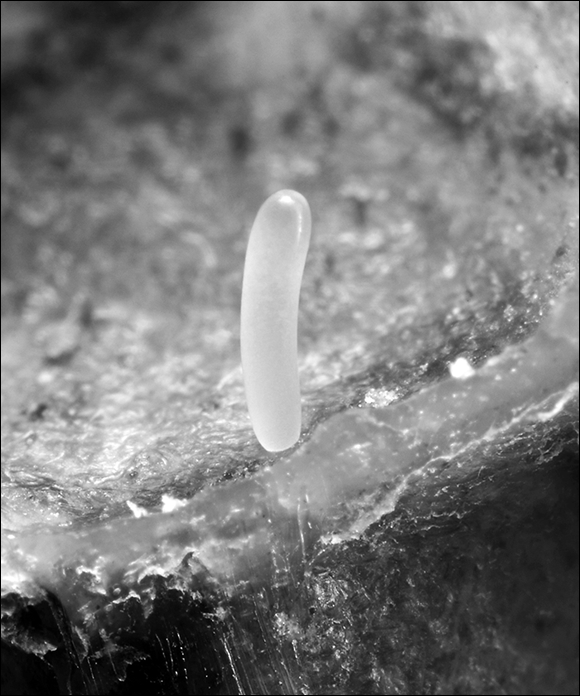
Courtesy of Alexander Wild, www.alexanderwild.com
FIGURE 2-10: A single egg.

Courtesy of Howland Blackiston
FIGURE 2-11: These magnifying goggles (used by watchmakers and model makers) are a great beekeeping tool for finding those itty-bitty eggs.
Larva
Three days after the queen lays the egg, it hatches into a larva (the plural is larvae). Healthy larvae are glistening and snowy white and resemble small grubs curled like the letter C in the cells (see Figure 2-12). Tiny at first, the larvae grow quickly, shedding their skin five times. These helpless little creatures have voracious appetites, consuming meals 24 hours a day. The nurse bees first feed the larvae royal jelly, and later they’re weaned to a mixture of honey and pollen (sometimes referred to as bee bread). Within just five days, they are 1,500 times larger than their original size. At this time the worker bees seal the larvae in the cell with a porous capping of tan beeswax. Once sealed in, the larvae spin a cocoon around their bodies.

Courtesy of John Clayton
FIGURE 2-12: Beautiful, pearly white little larvae curled up in their cells.
Pupa
The larva is now officially a pupa (the plural is pupae). Here’s where things really begin to happen but are not visible to the beekeeper The changes are hidden from sight under the wax cappings. But if you could, you’d see that this little creature is quickly beginning to take on the familiar features of an adult bee (see Figure 2-13). The eyes, legs, and wings take shape. Coloration begins with the eyes: first pink, then purple, and then black. Finally, the fine hairs that cover the bee’s body develop. After 12 days (in the case of the worker) the adult bee is now ready to chew her way through the wax capping to join her sisters and brothers. Figure 2-14 shows the entire life cycle, from start to finish, of the drone, worker and queen honey bees.
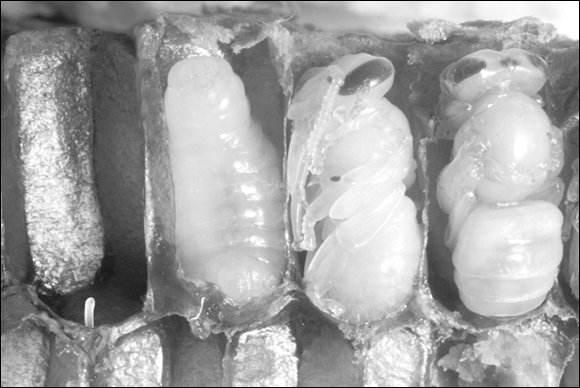
Courtesy of Dr. Edward Ross, California Academy of Sciences
FIGURE 2-13: Opened cells reveal an egg and developing pupae.
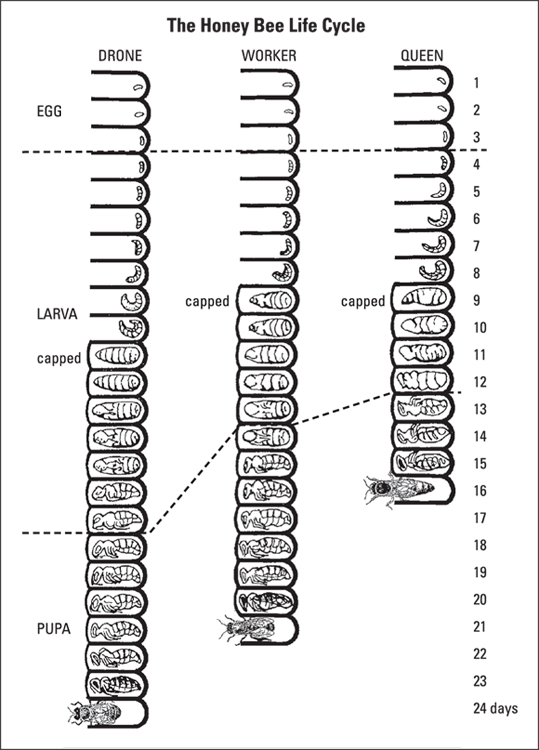
Courtesy of Howland Blackiston
FIGURE 2-14: This chart shows the daily development cycle of the two female castes and the drone, from egg to adult.
Other Stinging Insects
Many people are quick to say they’ve been “stung by a bee,” but the chances of a honey bee stinging them are rather slim. Honey bees usually are gentle in nature, and it is rare for an individual to be randomly stung by a honey bee. Honey bees sting as a defensive behavior; they are most likely to sting around the hive or when disturbed while foraging on a flower.
Other stinging insects, especially some of the wasps, are the more likely culprits to sting someone. Most folks, however, don’t make the distinction between honey bees and wasps. They incorrectly lump all insects with stingers into the “bee” category. True bees are unique in that their bodies are covered with hair, and they use pollen and nectar from plants as their sole source of food (they’re not the ones raiding your hamburger at a picnic — those are likely to be yellow-jacket wasps). Here are some of the most common stinging insects.
Bumblebee
The gentle bumble bee, sometimes called a humble bee (see Figure 2-15), is large, plump, mostly black and yellow, and hairy. It’s a familiar sight, buzzing loudly from flower to flower, collecting pollen and nectar. Bumblebees live in small ground nests, and all but newly reared next season queens die off every autumn. At the peak of summer, the colony is only a few hundred strong. Bumble bees make honey, but only small amounts (measured in ounces, not pounds). They are generally quite docile and not inclined to sting unless they or their nest is disturbed.
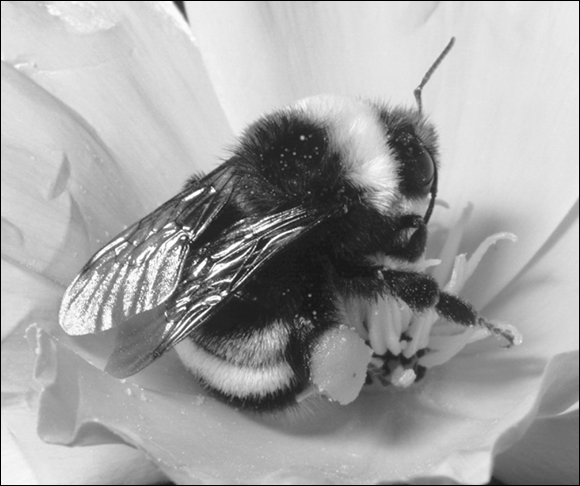
Courtesy of Dr. Edward Ross, California Academy of Sciences
FIGURE 2-15: The bumble bee is furry and plump.
Carpenter bee
The carpenter bee (see Figure 2-16) looks much like a bumble bee, but its habits are quite different. It is a solitary bee that makes its nest by tunneling through solid wood (sometimes the wooden eaves of a barn or shed). Like the honey bee, the carpenter bee forages for pollen. Its nest is small and produces only a few dozen offspring a season. Carpenter bees are gentle and are not likely to sting. But they can do some serious damage to the woodwork on your house.
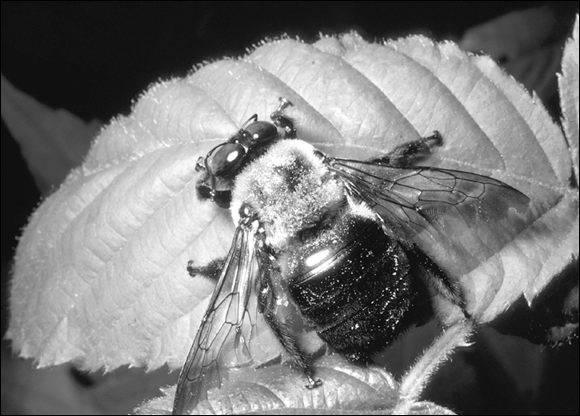
Courtesy of Dr. Edward Ross, California Academy of Sciences
FIGURE 2-16: The carpenter bee looks similar to a bumblebee, but its abdomen has no hair.
Mason bee
A bit similar in appearance to honey bees, the mason bee is a very important contributor to effective pollination. Unlike honey bees or bumble bees, mason bees are solitary, meaning there is no queen bee, and every female is fertile, making her own nest. Mason bees produce neither honey nor beeswax. In the wild, they build their mud-sealed nests in natural tubes like reeds or holes in dead trees. There has been a considerable insurgence of interest in these lovely insects, and commercially manufactured nests are available to house mason bees for the pollination of gardens and orchards (see Figure 2-17). Although mason bees do have stingers, they are very gentle. Even if you do get stung, it is more like a mosquito bite than a painful bee, wasp, or hornet sting.
Wasp
Many different kinds of insects are called wasps. The more familiar of these are distinguished by their smooth, hard bodies (usually brown or black) and distinctive ultra-thin wasp waist (see Figure 2-18). Social wasps build exposed paper nests, which usually are rather small and contain only a handful of adults and brood. There are no food stores. These nests sometimes are located where we’d rather not have them (in a door frame or windowsill). The slightest disturbance can lead to defensive behavior and stings. Social wasps primarily are meat eaters, but adult wasps are attracted to sweets. Note that wasps and hornets have smooth stingers (no barbs) and can inflict their fury over and over again. Ouch!

Courtesy of www.crownbees.com
FIGURE 2-17: A commercially available mason-bee nest.
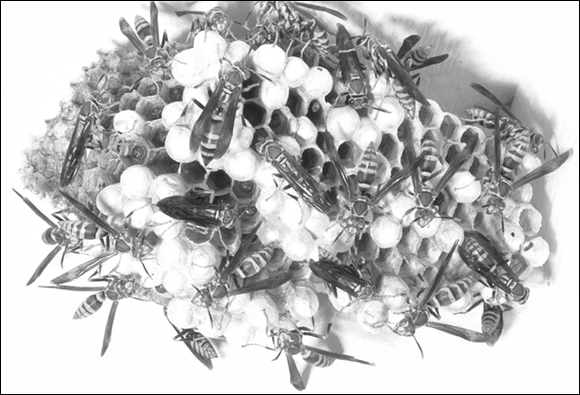
Courtesy of Dr. Edward Ross, California Academy of Sciences
FIGURE 2-18: The wasp is clearly identified by its smooth, hairless body and narrow wasp waist.
Yellow jacket
The yellow jacket also is a social wasp. Fierce and highly aggressive, it is likely responsible for most of the stings wrongly attributed to honey bees (see Figure 2-19). Yellow jackets are a familiar sight at summer picnics, where they scavenge for food and sugary drinks. Two basic kinds of yellow jackets exist: those that build their paper nests underground (which can create a problem when noisy lawn mowers or thundering feet pass overhead) and those that make their nests in trees. All in all, yellow jackets aren’t very friendly bugs.
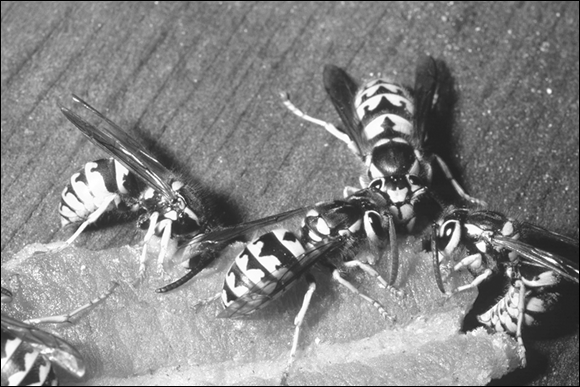
Courtesy of Dr. Edward Ross, California Academy of Sciences
FIGURE 2-19: The ill-tempered yellow jacket is a meat eater but also has a taste for sweets.
Bald-faced hornet
Bald-faced hornets are not loveable creatures (see Figure 2-20). Nor are they true hornets. Typically found in the eastern United States, they are in fact aerial-nesting yellow jackets, building their nests above ground (in trees or bushes). They are highly defensive, have a painful sting, and are ruthless hunters and meat eaters. They do, however, build fantastically impressive and beautiful paper nests from their saliva and wood fiber they harvest from dead trees (see Figure 2-21). These nests can grow large during the summer and eventually reach the size of a basketball. Such nests can contain several thousand large, hot-tempered hornets — keep your distance! The end of the summer marks the end of the hornet city. When the cool weather approaches, the nest is abandoned, and only a newly raised queen survives. She finds a warm retreat underground and emerges in the spring, raising young and building a new nest.
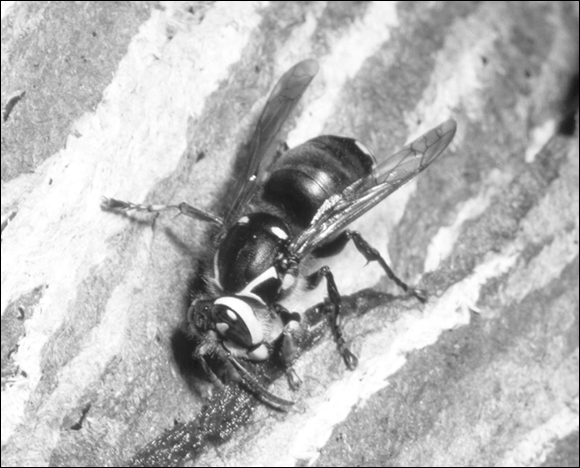
Courtesy of Dr. Edward Ross, California Academy of Sciences
FIGURE 2-20: The bald-faced hornet makes impressive paper nests in trees.
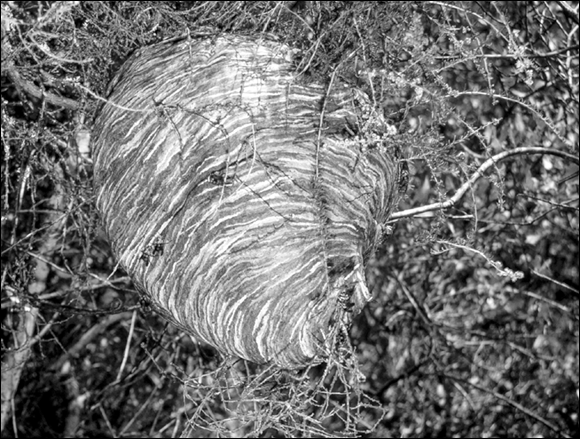
Courtesy of Howland Blackiston
FIGURE 2-21: A large paper nest made by a colony of bald-faced hornets.
 As a beekeeper, on every visit to the hive you need to determine two things: “Do I have a queen?” and “Is she healthy?”
As a beekeeper, on every visit to the hive you need to determine two things: “Do I have a queen?” and “Is she healthy?” Eggs are much easier to spot on a bright, sunny day. Hold the comb at a slight angle, with the sun behind you and shining over your shoulder, illuminating the deep recesses of the cell. The eggs are translucent white and resemble a miniature grain of rice. I recommend that you invest in an inexpensive pair of reading glasses. Better yet, get yourself a pair of magnifying goggles such as those used by watchmakers and model makers (see
Eggs are much easier to spot on a bright, sunny day. Hold the comb at a slight angle, with the sun behind you and shining over your shoulder, illuminating the deep recesses of the cell. The eggs are translucent white and resemble a miniature grain of rice. I recommend that you invest in an inexpensive pair of reading glasses. Better yet, get yourself a pair of magnifying goggles such as those used by watchmakers and model makers (see